Sony CDX-CA850 User Manual

Player Disc Compact FM/MW/LW
|
|
|
|
|
|
3-229-196-11 (1) |
|
FM/MW/LW |
|
|
|||||
Compact Disc |
|
|
|||||
Player |
|
|
|||||
|
|
|
|
|
|
|
|
|
|
|
|
|
|
|
|
Operating Instructions |
|
|
GB |
||||
|
|
|
|
|
|||
Bedienungsanleitung |
|
|
|
DE |
|||
|
|
|
|||||
|
|
|
|
|
|
||
Mode d’emploi |
|
|
|
|
|
|
FR |
|
|
|
|
|
|||
|
|
|
|
|
|||
Istruzioni per l’uso |
|
|
|
|
|
IT |
|
|
|
|
|
|
|
||
Gebruiksaanwijzing |
|
|
|
|
NL |
||
|
|
|
|||||
Wichtig!
Bitte nehmen Sie sich etwas Zeit, um den Geräte-Pass vollständig auszufüllen. Wo sich dieser befindet, entnehmen Sie bitte dem in der hinteren Umshlagseite dieser Bedienungsanleitung.
Si dichiara che l’apparecchio è stato fabbricato in conformità all’art. 2, Comma 1 del D.M. 28.08. 1995 n. 548.
For installation and connections, see the supplied installation/connections manual.
Zur Installation und zum Anschluß siehe die mitgelieferte Installations-/Anschlußanleitung.
En ce qui concerne l’installation et les connexions, consulter le manuel d’installation/ raccordement fourni.
Per l’installazione e i collegamenti, fare riferimento al manuale di istruzioni per l’installazione e i collegamenti in dotazione.
Zie voor het monteren en aansluiten van het apparaat de bijgeleverde handleiding “Installatie en aansluitingen”.
CDX-CA850
© 2001 Sony Corporation

Welcome !
Thank you for purchasing this Sony Compact Disc Player. You can enjoy its various features even more with:
•Display language*1 choice from English, German, French, Italian, Dutch, Spanish, Portuguese, Swedish, Polish, Czech, or Turkish.
•Optional CD/MD units (both changers and players)*2.
•Optional DAB tuner.
•CD TEXT information (displayed when a CD TEXT disc*3 is played).
•Supplied controller accessories
Rotary commander RM-X5S
Card remote commander RM-X113
•Optional controller accessory
Rotary commander RM-X4S
*1 Some display indications do not appear in the language you select.
*2 This unit works with Sony products only.
*3 A CD TEXT disc is an audio CD that includes information such as the disc name, artist name, and track names. This information is recorded on the disc.
2

Table of Contents
Location of controls. . . . . . . . . . . . . . . . . . . . 4 Precautions . . . . . . . . . . . . . . . . . . . . . . . . . . 6 Notes on discs . . . . . . . . . . . . . . . . . . . . . . . . 6
Getting Started
Resetting the unit . . . . . . . . . . . . . . . . . . . . . . 7 Detaching the front panel . . . . . . . . . . . . . . . 8 Setting the clock . . . . . . . . . . . . . . . . . . . . . . 9
CD Player
CD/MD Unit (optional)
Playing a disc. . . . . . . . . . . . . . . . . . . . . . . . . 9 Display items . . . . . . . . . . . . . . . . . . . . . . . . 10 Playing tracks repeatedly
— Repeat Play . . . . . . . . . . . . . . . . . . . . 10 Playing tracks in random order
— Shuffle Play . . . . . . . . . . . . . . . . . . . . 10 Labelling a CD
— Disc Memo*. . . . . . . . . . . . . . . . . . . . 11 Locating a disc by name
— List-up* . . . . . . . . . . . . . . . . . . . . . . . 12 Selecting specific tracks for playback
— Bank* . . . . . . . . . . . . . . . . . . . . . . . . . 12
* Functions available with optional CD/MD unit
Radio
Storing stations automatically
— Best Tuning Memory (BTM). . . . . . . 13 Receiving the stored stations . . . . . . . . . . . . 14 Storing only the desired stations . . . . . . . . . 14 Tuning in a station through a list
— List-up . . . . . . . . . . . . . . . . . . . . . . . . 15
RDS
Overview of RDS . . . . . . . . . . . . . . . . . . . . 15 Automatic retuning for best reception results
— AF function . . . . . . . . . . . . . . . . . . . . 16 Receiving traffic announcements
— TA/TP . . . . . . . . . . . . . . . . . . . . . . . . 17 Presetting RDS stations with AF and TA
setting . . . . . . . . . . . . . . . . . . . . . . . . . . . 17 Tuning in stations by programme type
— PTY . . . . . . . . . . . . . . . . . . . . . . . . . . 18 Setting the clock automatically
— CT . . . . . . . . . . . . . . . . . . . . . . . . . . . 19
DAB (optional)
Overview of DAB . . . . . . . . . . . . . . . . . . . . 19 Basic operations of DAB . . . . . . . . . . . . . . 20 Presetting DAB services automatically
— BTM . . . . . . . . . . . . . . . . . . . . . . . . . 21 Presetting DAB services manually
— Preset Edit . . . . . . . . . . . . . . . . . . . . . 21 Tuning in DAB programme through
a list . . . . . . . . . . . . . . . . . . . . . . . . . . . . 22 Switching multi-channel audio and
DRC . . . . . . . . . . . . . . . . . . . . . . . . . . . . 23 Locating a DAB service by programme type
(PTY) . . . . . . . . . . . . . . . . . . . . . . . . . . . 23
Other Functions
Using the rotary commander. . . . . . . . . . . . 24 Adjusting the sound characteristics . . . . . . 26 Quickly attenuating the sound . . . . . . . . . . 26 Changing the sound and display settings
— Menu . . . . . . . . . . . . . . . . . . . . . . . . . 26 Setting the equalizer . . . . . . . . . . . . . . . . . . 27 Setting the Dynamic Soundstage Organizer
(DSO) . . . . . . . . . . . . . . . . . . . . . . . . . . . 28 Selecting the spectrum analyzer . . . . . . . . . 28 Labelling a Motion Display . . . . . . . . . . . . 29
Additional Information
Maintenance . . . . . . . . . . . . . . . . . . . . . . . . 29 Removing the unit. . . . . . . . . . . . . . . . . . . . 30 Specifications . . . . . . . . . . . . . . . . . . . . . . . 31 Troubleshooting . . . . . . . . . . . . . . . . . . . . . 32 Error displays/Messages . . . . . . . . . . . . . . . 33
3
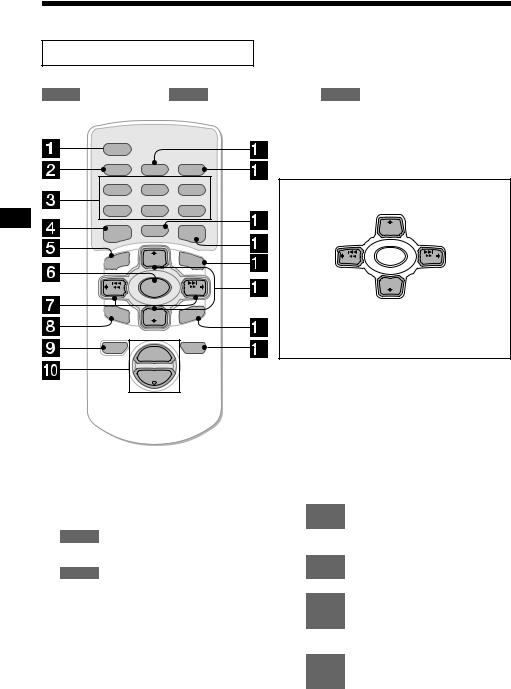
Location of controls
Card remote commander RM-X113
Refer to the pages listed for details.
CD/MD : During Playback RADIO : During radio reception MENU : During menu mode
 SCRL
SCRL
PTY
DSPL |
AF |
TA |
REP |
SHUF |
|
1 |
2 |
3 |
4 |
5 |
6 |
DSO |
MODE |
EQ7 |
MENU |
DISC + |
LIST |
SEEK– |
SOURCE |
SEEK+ |
|
||
SOUND |
DISC – |
ENTER |
OFF |
+ |
ATT |
|
VOL |
|
|
– |
|
(DISC)
(+): to select upwards
(SEEK) |
|
|
|
(–): to select |
|
DISC + |
|
leftwards/ |
|
|
|
|
|
|
|
. |
|
|
|
|
SEEK– |
SOURCE |
SEEK+ |
|
|
||
|
|
DISC – |
(SEEK) |
|
|
(+): to select |
|
|
|
|
|
|
|
|
rightwards/ |
|
|
(DISC) |
> |
(–): to select downwards
In menu mode, the currently selectable button (s) of these four are indicated with a “ v” in the display.
Tip
Refer to “Replacing the lithium battery” for details on how to replace the batteries (page 30).
a SCRL button 10
b DSPL/PTY (display mode change/ programme type) button 10, 11, 15, 18, 23, 29
cNumber buttons
CD/MD
(1)REP 10
(2)SHUF 10
RADIO 14, 16, 17, 20, 22 d DSO button 28
eMENU button 9, 11, 12, 13, 17, 19, 21, 23, 27, 28, 29
fSOURCE (Power on/Radio/CD/MD) button 9, 10, 11, 13, 14, 17, 20, 27, 28
g SEEK buttons (–/+) 26
CD/MD |
9 |
RADIO |
14, 16, 20 |
MENU |
9, 11, 12, 13, 19, 21, 23, 27, 28, |
|
29 |
|
h SOUND button 26 |
4 |
i OFF (Stop/Power off) button 8, 9, 29 |
j VOL buttons (+/–) 17 |
k AF button 16, 17 l TA button 17
m MODE button
CD/MD 10, 11
RADIO 13, 14, 17, 20 n EQ7 button 27
oLIST button
CD/MD 11, 12
RADIO 15, 22
pDISC buttons (+/–)
CD/MD 10, 12
RADIO 14, 15, 18, 20, 22, 23
MENU 9, 11, 12, 13, 17, 19, 21, 23, 27, 28, 29
qENTER button
CD/MD 12
RADIO 15, 18, 22, 23
MENU 9, 11, 12, 13, 17, 19, 21, 23, 27, 28, 29
r ATT button 26
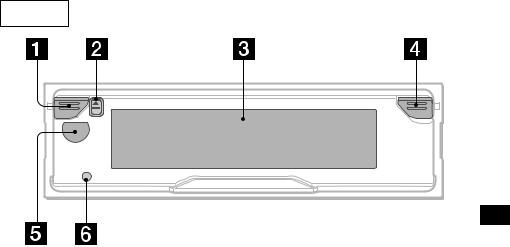
Main unit
OPEN
CDX-CA850
a Power on/off button*
bZ(eject) button (located on the front side of the unit, behind the front panel) 9
c Display window d OPEN button 8, 9
e Receptor for the card remote commander and rotary commander
fRESET button (located on the front side of the unit, behind the front panel) 7
*Warning when installing in a car without an ACC (accessory) position on the ignition switch
After turning off the ignition, be sure to press the power on/off button on the unit (or (OFF) on the card remote commander or the rotary commander) for 2 seconds to turn off the clock display.
Otherwise, the clock display does not turn off and this causes battery drain.
To turn the unit on, press the power on/off button (1) on the unit.
Note
If the unit is turned off by pressing the power on/ off button on the unit (or (OFF) on the card remote commander or the rotary commander) for 2 seconds, the unit cannot be operated with the card remote commander or the rotary commander unless the power on/off button on the unit is pressed or a disc is inserted to activate the unit.
5
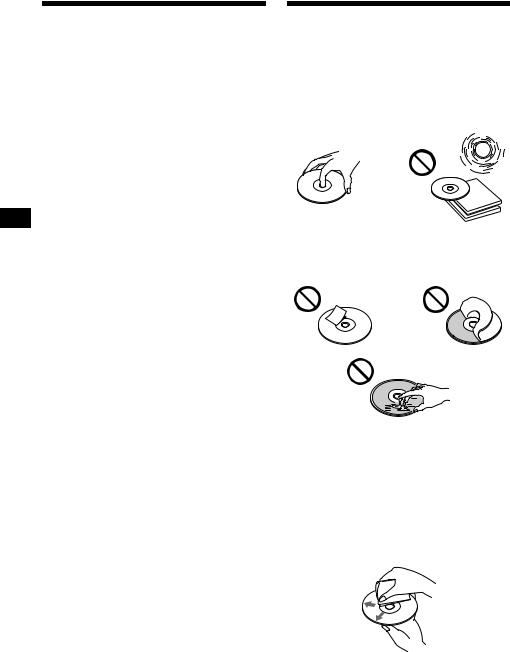
Precautions
•If your car was parked in direct sunlight, allow the unit to cool off before operating it.
•Power aerials will extend automatically while the unit is operating.
If you have any questions or problems concerning your unit that are not covered in this manual, please consult your nearest Sony dealer.
Moisture condensation
On a rainy day or in a very damp area, moisture condensation may occur inside the lenses and display of the unit. Should this occur, the unit will not operate properly. In such a case, remove the disc and wait for about an hour until the moisture has evaporated.
To maintain high sound quality
Be careful not to splash juice or other soft drinks onto the unit or discs.
Notes on discs
•To keep the disc clean, do not touch the surface. Handle the disc by its edge.
•Keep your discs in their cases or disc magazines when not in use.
Do not subject the discs to heat/high temperature. Avoid leaving them in parked cars or on dashboards/rear trays.
•Do not attach labels, or use discs with sticky ink/residue. Such discs may stop spinning when used, causing a malfunction, or may ruin the disc.
•Discs with non-standard shapes (e.g., heart, square, star) cannot be played on this unit. Attempting to do so may damage the unit. Do not use such discs.
•You cannot play 8 cm CDs.
•Before playing, clean the discs with a commercially available cleaning cloth. Wipe each disc from the centre out. Do not use solvents such as benzine, thinner, commercially available cleaners, or antistatic spray intended for analog discs.
6

Notes on CD-R/CD-RW discs
•You can play CD-Rs (recordable CDs) designed for audio use on this unit.
Look for this mark to distinguish CD-Rs for audio use.
This mark denotes that a disc is not for audio use.
•Some CD-Rs (depending on the equipment used for its recording or the condition of the disc) may not play on this unit.
•You cannot play a CD-R that is not finalized*.
*A process necessary for a recorded CD-R disc to be played on the audio CD player.
•You cannot play CD-RWs (rewritable CDs) on this unit.
Getting Started
Resetting the unit
Before operating the unit for the first time, or after replacing the car battery or changing the connections, you must reset the unit.
Remove the front panel and press the RESET button with a pointed object, such as a ballpoint pen.
RESET button
Note
Pressing the RESET button will erase the clock setting and some stored contents.
7

Detaching the front panel
You can detach the front panel of this unit to protect the unit from being stolen.
Caution alarm
If you turn the ignition switch to the OFF position without removing the front panel, the caution alarm will beep for a few seconds.
If you connect an optional amplifier and do not use the built-in amplifier, the beep sound will be deactivated.
1 Press the power on/off button on the unit (or (OFF) on the card remote commander or the rotary commander)*.
CD/MD playback or radio reception stops (the display remains on).
*If your car has no ACC position on the ignition switch, be sure to turn the unit off by pressing the power on/off button on the unit (or (OFF) on the card remote commander or the rotary commander) for 2 seconds to avoid car battery drain.
2 Press (OPEN), then slide the front panel to the right, and gently pull out the left end of the front panel.
1

2
Notes
•If you detach the panel while the unit is still turned on, the power will turn off automatically to prevent the speakers from being damaged.
•Do not drop or put excessive pressure on the front panel and its display window.
•Do not subject the front panel to heat/high temperature or moisture. Avoid leaving it in parked cars or on dashboards/rear trays.
Tip
When carrying the front panel with you, use the supplied front panel case.
Attaching the front panel
Place hole A of the front panel onto the spindle B on the unit, then lightly push the left side in.
A
B
x
Note
Do not put anything on the inner surface of the front panel.
8

Setting the clock
The clock uses a 24-hour digital indication.
Example: To set the clock to 10:08
1 Press (MENU), then press either side of (DISC) repeatedly until “Clock” appears.
1Press (ENTER).
The hour indication flashes.
2Press either side of (DISC) to set the hour.
3Press the (+) side of (SEEK).
The minute indication flashes.
4Press either side of (DISC) to set the minute.
2 Press (ENTER).
The clock starts. After the clock setting is completed, the display returns to normal play mode.
Tips
•You can set the clock automatically with the RDS feature (page 19).
•When D.Info mode is set to on, the time is always displayed (page 26).
CD Player
CD/MD Unit (optional)
In addition to playing a CD with this unit, you can also control external CD/MD units.
Note
If you connect an optional CD unit with the CD TEXT function, the CD TEXT information will appear in the display when you play a CD TEXT disc.
Playing a disc
(With this unit)
1 Press (OPEN) and insert the disc
(labelled side up).
2 Close the front panel.
Playback starts automatically.
If a disc is already inserted, press (SOURCE) repeatedly until “CD” appears to start playback.
To |
Press |
Stop playback |
(OFF) |
|
|
Eject the disc |
(OPEN) then Z |
|
|
Skip tracks |
(SEEK) (./>) |
– Automatic |
[once for each track] |
Music Sensor |
|
|
|
Fast-forward/ |
(SEEK) (m/M) |
reverse |
[hold to desired point] |
– Manual Search |
|
|
|
|
continue to next page t |
9
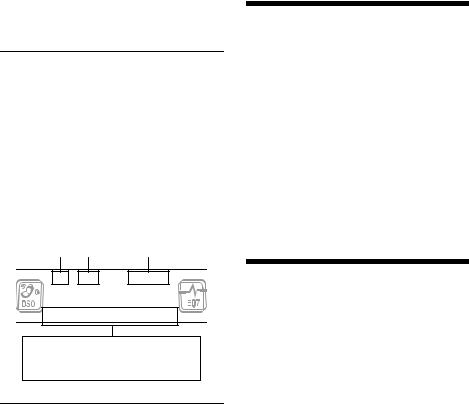
Notes
•When the last track on the disc is over, playback restarts from the first track of the disc.
•With optional unit connected, playback of the same source will continue on to the optional CD/MD unit.
(With optional unit)
1 Press (SOURCE) repeatedly to select
“CD” or “MD.”
2 Press (MODE) repeatedly until the desired unit appears.
Playback starts.
|
|
To |
Press |
|
|
Skip discs |
(DISC) (+/–) |
|
|
– Disc selection |
|
|
|
||
|
|
|
|
|
|
|
|
|
|
|
|
|
|
|
|
Display items
When the disc/track changes, any prerecorded title*1 of the new disc/track is automatically displayed (if the Auto Scroll function is set to “on,” names exceeding 8 characters will be scrolled (page 26)).
Disc |
Track |
Elapsed |
number |
number |
playing time |
Notes
•Some characters cannot be displayed.
•For some CD TEXT discs with very many characters, information may not scroll.
•This unit cannot display the artist name for each track of a CD TEXT disc.
Tip
When Auto scroll is set to off and the disc/track name is changed, the disc/track name does not scroll.
Playing tracks repeatedly
— Repeat Play
The disc in the main unit will repeat a track or the entire disc when it reaches the end. For repeat play, you can select:
•Repeat 1 — to repeat a track.
•Repeat 2* — to repeat a disc.
*Available only when one or more optional CD/MD units are connected.
During playback, press (1) (REP) repeatedly until the desired setting appears in the display.
Repeat Play starts.
To return to normal play mode, select “Repeat off.”
Displayable items
•Disc name*1/artist name*2
•Track title*1
To |
Press |
Switch display |
(DSPL/PTY) |
item |
|
|
|
Scroll display item |
(SCRL) |
|
|
*1 When pressing (DSPL/PTY), “NO D.Name” or “NO T.Name” indicates that there is no Disc Memo (page 11) or prerecorded name to display.
*2 Only for CD TEXT discs with the artist name.
Playing tracks in random order
— Shuffle Play
You can select:
•Shuf 1 — to play the tracks on the current disc in random order.
•Shuf 2*1 — to play the tracks in the current optional CD (MD) unit in random order.
•Shuf All*2 — to play all the tracks in all the connected CD (MD) units (including this unit) in random order.
*1 Available only when one or more optional CD (MD) units are connected.
*2 Available only when one or more optional CD units, or two or more optional MD units are connected.
During playback, press (2) (SHUF) repeatedly until the desired setting appears in the display.
Shuffle Play starts.
To return to normal play mode, select “Shuf off.”
Note
“Shuf All” will not shuffle tracks between CD units and MD units.
10
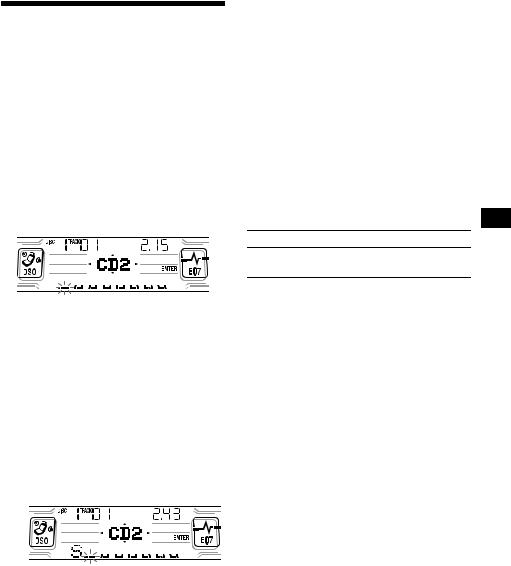
Labelling a CD
— Disc Memo (For a CD unit with the CUSTOM FILE function)
You can label each disc with a custom name (Disc Memo). You can enter up to 8 characters for a disc. If you label a CD, you can locate the disc by name (page 12).
1 Start playing the disc you want to label in a CD unit with the CUSTOM FILE function.
2 Press (MENU), then press either side of (DISC) repeatedly until “Name Edit” appears.
3 Press (ENTER).
The unit will repeat the disc during the labelling procedure.
4 Enter the characters.
1Press the (+)*1 side of (DISC) repeatedly to select the desired character.
A t B t C ... t 0 t 1 t 2 ... t + t – t * ... t  *2 t A
*2 t A
*1 For reverse order, press the (–) side of
(DISC).
*2 (blank space)
2Press the (+) side of (SEEK) after locating the desired character.
If you press the (–) side of (SEEK), you can move back to the left.
3Repeat steps 1 and 2 to enter the entire name.
5 To return to normal CD play mode, press (ENTER).
Tips
•Simply overwrite or enter “  ” to correct or erase a name.
” to correct or erase a name.
•There is another way to start labelling a CD: Press (LIST) for 2 seconds instead of performing steps 2 and 3. You can also complete the operation by pressing (LIST) for 2 seconds instead of step 5.
•You can label CDs on a unit without the CUSTOM FILE function if that unit is connected along with a CD unit that has the function. The Disc Memo will be stored in the memory of the CD unit with the CUSTOM FILE function.
Note
Repeat/shuffle play is suspended until the Name Edit is complete.
Viewing the Disc Memo
As a display item, the Disc Memo always takes priority over any original CD TEXT information.
To |
Press |
View |
(DSPL/PTY) during CD/CD |
|
TEXT disc playback |
Tip
To find out about other items that can be displayed, see page 10.
Erasing the Disc Memo
1 Press (SOURCE) repeatedly to select
“CD.”
2 Press (MODE) repeatedly to select the
CD unit storing the Disc Memo.
3 Press (MENU), then press either side of (DISC) repeatedly until “Name Del” appears.
4 Press (ENTER).
The stored names will appear.
5 Press either side of (DISC) repeatedly to select the disc name you want to erase.
The stored names will appear.
6 Press (ENTER) for 2 seconds.
The name is erased.
Repeat steps 5 and 6 if you want to erase other names.
7 Press (MENU) twice.
The unit returns to normal CD play mode.
Notes
•When the Disc Memo for a CD TEXT disc is erased, the original CD TEXT information is displayed.
•If you cannot find the Disc Memo you want to erase, try selecting a different CD unit in step 2.
11
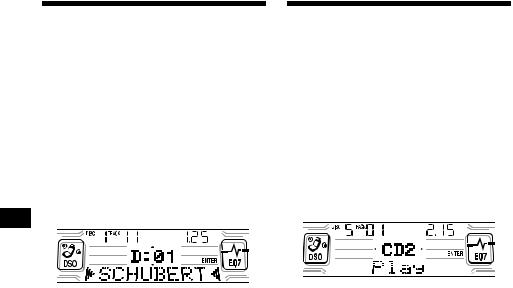
Locating a disc by name
— List-up (For a CD unit with the CD TEXT/ CUSTOM FILE function, or an MD unit)
You can use this function for discs that have been assigned custom names*1 or for CD TEXT discs*2.
*1 Locating a disc by its custom name: when you assign a name for a CD (page 11) or an MD.
*2 Locating discs by the CD TEXT information: when you play a CD TEXT disc on a CD unit with the CD TEXT function.
1 Press (LIST).
The name assigned to the current disc appears in the display.
2 Press either side of (DISC) repeatedly until you find the desired disc.
3 Press (ENTER) to play the disc.
Note
Some letters cannot be displayed (exception: Disc Memo).
12

Playing specific tracks only
You can select:
•Bank on — to play the tracks with the “Play” setting.
•Bank inv (Inverse) — to play the tracks with the “Skip” setting.
1 During playback, press (MENU), then press either side of (DISC) repeatedly until “Bank on,” “Bank inv,” or “Bank off” appears.
2 Press the (+) side of (SEEK) repeatedly until the desired setting appears.
3 Press (ENTER).
Playback starts from the track following the current one.
To return to normal play mode, select “Bank off” in step 2.
Radio
The unit can store up to 6 stations per band (FM1, FM2, FM3, MW, and LW).
Caution
When tuning in stations while driving, use Best Tuning Memory to prevent accidents.
Storing stations automatically
— Best Tuning Memory (BTM)
The unit selects the stations with the strongest signals within the selected band, and stores them in the order of their frequency.
1 Press (SOURCE) repeatedly to select the radio.
2 Press (MODE) repeatedly to select the band.
3 Press (MENU), then press either side of (DISC) repeatedly until “BTM” appears.
4 Press (ENTER).
A beep sounds when the setting is stored.
Notes
•If only a few stations can be received due to weak signals, some number buttons will retain their former settings.
•When a number is indicated in the display, the unit starts storing stations from the one currently displayed.
13

Receiving the stored stations
1 Press (SOURCE) repeatedly to select the radio.
2 Press (MODE) repeatedly to select the band.
3 Press the number button ((1) to (6)) on which the desired station is stored.
Tip
Press either side of (DISC) to receive the stations in the order they are stored in the memory (Preset Search function).
If preset tuning does not work
Press either side of (SEEK) to search for the station (automatic tuning).
Scanning stops when the unit receives a station. Repeat until the desired station is received.
Tips
•If automatic tuning stops too frequently, turn on the Local Seek to limit seek to stations with stronger signals (see “Changing the sound and display settings” on page 26).
•If you know the frequency of the station you want to listen to, press and hold either side of (SEEK) to locate the approximate frequency, then press (SEEK) repeatedly to fine adjust to the desired frequency (manual tuning).
If FM stereo reception is poor
Select monaural reception mode
(see “Changing the sound and display settings” on page 26).
The sound improves, but becomes monaural (“ST” disappears).
Storing only the desired stations
You can manually preset the desired stations on any chosen number button.
1 Press (SOURCE) repeatedly to select the radio.
2 Press (MODE) repeatedly to select the band.
3 Press either side of (SEEK) to tune in the station that you want to store.
4 Press the desired number button ((1) to (6)) for 2 seconds until “MEM” appears.
The number button indication appears in the display.
Note
If you try to store another station on the same number button, the previously stored station will be erased.
14
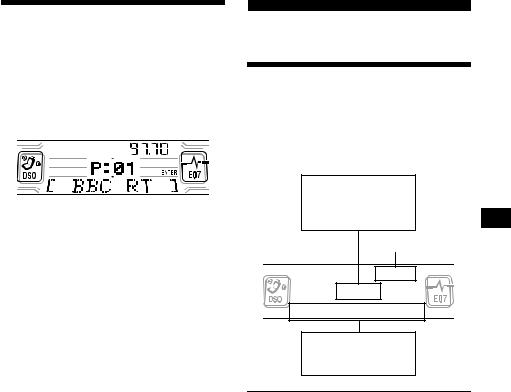
Tuning in a station through a list
— List-up
1 During radio reception, press (LIST) momentarily.
The frequency or the name assigned to the current station appears in the display.
2 Press either side of (DISC) repeatedly until you find the desired station.
If no name is assigned to the selected station, the frequency appears in the display.
3 Press (ENTER) to tune in the desired station.
RDS
Overview of RDS
FM stations with Radio Data System (RDS) service send inaudible digital information along with the regular radio programme signal. For example, one of the following will be displayed upon receiving a station with RDS capability.
Displayable items
•Radio band
•Clock
•Function
Frequency
Displayable items
•Station name
•Programme type
To |
Press |
Switch display |
(DSPL/PTY) |
item |
|
|
|
RDS services
RDS data offers you other conveniences, such as:
•Automatic retuning of a programme, helpful during long-distance drives. — AF t page 16
•Receiving traffic announcements, even when enjoying another programme/source. — TA t page 17
•Selecting stations by the type of programme it broadcasts. — PTY t page 18
•Automatic clock time setting. — CT t page 19
Notes
•Depending on the country or region, not all of the RDS functions are available.
•RDS may not work properly if the signal strength is weak or if the station you are tuned to is not transmitting RDS data.
15

Automatic retuning for best reception results
— AF function
The alternative frequencies (AF) function allows the radio to always tune into the area’s strongest signal for the station you are listening to.
Frequencies change automatically.
96.0 MHz
98.5 MHz
Station
102.5 MHz
1 Select an FM station (page 13).
2 Press (AF) repeatedly until “AF on” appears.
The unit starts searching for an alternative frequency with a stronger signal in the same network.
If “NO AF” flashes, the currently tuned into station does not have an alternative frequency.
Note
When there is no alternative frequency in the area or when you do not need to search for one, turn the AF function off by selecting “AF off.”
For stations without alternative frequencies
Press either side of (SEEK) while the station name is flashing (within
8 seconds).
The unit starts searching for another frequency with the same PI (Programme Identification) data (“PI Seek” appears).
If the unit cannot find the same PI, the unit returns to the previously selected frequency.
Staying with one regional programme
When AF function is on: this unit’s factory-set setting restricts reception to a specific region, so you won’t be switched to another regional station with a stronger frequency.
If you leave this regional programme’s reception area or would like to take advantage of the whole AF function, select “REG off” from the MENU (page 27).
Note
This function does not work in the United Kingdom and in some other areas.
Local Link function (United Kingdom only)
This function enables you to select other local stations in the area, even if they are not stored on your number buttons.
1 Press a number button ((1) to (6)) that has a local station stored on it.
2 Within 5 seconds, press the number button of the local station again.
3 Repeat this procedure until the desired local station is received.
16

Receiving traffic announcements
— TA/TP
By activating the Traffic Announcement (TA) and Traffic Programme (TP), you can automatically tune in an FM station broadcasting traffic announcements. These settings function regardless of the current FM programme/source, CD/MD; the unit switches back to the original source when the bulletin is over.
Press (TA) repeatedly until “TA on” appears.
The unit starts searching for traffic information stations.
“TP” indicates reception of such stations, and “TA” flashes during an actual traffic announcement. The unit will continue searching for stations available with TP if “NO TP” is indicated.
To cancel all traffic announcements, select “TA off.”
To |
Press |
Cancel current |
(TA) |
announcement |
|
|
|
Tip
You can also cancel the current announcement by pressing (SOURCE) or (MODE).
Presetting the volume of traffic announcements
You can preset the volume level of the traffic announcements so you won’t miss hearing them.
1 Press (VOL) to adjust the desired volume level.
2 Press (TA) for 2 seconds.
“TA” appears and the setting is stored.
Receiving emergency announcements
If either AF or TA is on, the unit will switch to emergency announcements, if one comes in while listening to an FM station or CD/MD.
Presetting RDS stations with AF and TA setting
When you preset RDS stations, the unit stores each station’s AF/TA setting (on/off) as well as its frequency. You can select a different setting (for AF, TA, or both) for individual preset stations, or the same setting for all preset stations. If you preset stations with “AF on,” the unit automatically stores stations with the strongest radio signal.
Presetting the same setting for all preset stations
1 Select an FM band (page 13).
2 Press (AF) and/or (TA) to select “AF on” and/or “TA on.”
Note that selecting “AF off” or “TA off” stores not only RDS stations, but also nonRDS stations.
3 Press (MENU), then press either side of (DISC) repeatedly until “BTM” appears.
4 Press (ENTER) until “BTM” flashes.
Presetting different settings for each preset station
1 Select an FM band, and tune in the desired station (page 14).
2 Press (AF) and/or (TA) to select “AF on” and/or “TA on.”
3 Press the desired number button ((1) to (6)) until “MEM” appears.
Repeat from step 1 to preset other stations.
17

Tuning in stations by programme type
— PTY
You can tune in a station by selecting the type of programme you would like to listen to.
|
|
Programme types |
Display |
|
|
News |
News |
|
|
|
|
|
|
Current Affairs |
Affairs |
|
|
|
|
|
|
Information |
Info |
|
|
|
|
|
|
Sports |
Sport |
|
|
|
|
|
|
Education |
Educate |
|
|||
|
|
|
|
|
|
Drama |
Drama |
|
|||
|
|
|
|
|
|
Culture |
Culture |
|
|
|
|
|
|
Science |
Science |
|
|
|
|
|
|
Varied |
Varied |
|
|
|
|
|
|
Popular Music |
Pop M |
|
|
|
|
|
|
Rock Music |
Rock M |
|
|
|
|
|
|
Easy Listening |
Easy M |
|
|
|
|
|
|
Light Classical |
Light M |
|
|
|
|
|
|
Classical |
Classics |
|
|
|
|
|
|
Other Music Type |
Other M |
|
|
|
|
|
|
Weather |
Weather |
|
|
|
|
|
|
Finance |
Finance |
|
|
|
|
|
|
Children’s Programmes |
Children |
|
|
|
|
|
|
Social Affairs |
Social A |
|
|
|
|
|
|
Religion |
Religion |
|
|
|
|
|
|
Phone In |
Phone In |
|
|
|
|
|
|
Travel |
Travel |
|
|
|
|
|
|
Leisure |
Leisure |
|
|
|
|
|
|
Jazz Music |
Jazz |
|
|
|
|
|
|
Country Music |
Country |
|
|
|
|
|
|
National Music |
Nation M |
|
|
|
|
|
|
Oldies Music |
Oldies |
|
|
|
|
|
|
Folk Music |
Folk M |
|
|
|
|
|
|
Documentary |
Document |
|
|
|
|
Note
You cannot use this function in some countries where no PTY (Programme Type selection) data is available.
1 Press (DSPL/PTY) during FM reception until “PTY” appears.
The current programme type name appears if the station is transmitting the PTY data. “--------” appears if the received station is not an RDS station, or if the RDS data is not received.
2 Press (DISC) repeatedly until the desired programme type appears.
The programme types appear in the order shown in the table.
“--------” appears if the programme type is not specified in the RDS data.
3 Press (ENTER).
The unit starts searching for a station broadcasting the selected programme type.
18

Setting the clock automatically
— CT
The CT (Clock Time) data from the RDS transmission sets the clock automatically.
1 During radio reception, press (MENU), then press either side of (DISC) repeatedly until “CT off” appears.
2 Press the (+) side of (SEEK) repeatedly until “CT on” appears.
The clock is set.
3 Press (ENTER) to return to the normal display.
To cancel the CT function, select “CT off” in step 2.
Notes
•The CT function may not work even though an RDS station is being received.
•There might be a difference between the time set by the CT function and the actual time.
DAB (optional)
You can connect an optional DAB tuner to this unit.
Overview of DAB
DAB (Digital Audio Broadcasting) is a new multimedia broadcasting system that transmits audio programmes with a quality comparable to that of CDs. This is made possible by the use of a microcomputer in the DAB tuner which uses the radio signals sent from multiple aerials and multi-path signals (reflected radio waves) to boost the strength of the main signal. This makes DAB almost immune to radio interference even in a moving object such as a car.
Each DAB station bundles radio programmes (services) into an ensemble which it then broadcasts. Each service contains one or more components. All ensembles, services, and components are identified by name, so you can access any of them without having to know their frequencies.
DAB programme
Ensemble
Service
Service
Service
Component
Component
Component
Notes
•The DAB system is still in a testing phase. Some services have not been sufficiently defined or are presently being tested. At present, such services are not supported by the optional DAB tuner unit XT100DAB.
•DAB programmes are broadcast in Band-III (174 to 240 MHz) and L-Band (1,452 to 1,492 MHz), with each band divided into channels (41 in Band-III and 23 in L-Band). One ensemble is broadcast per channel by each DAB station.
19
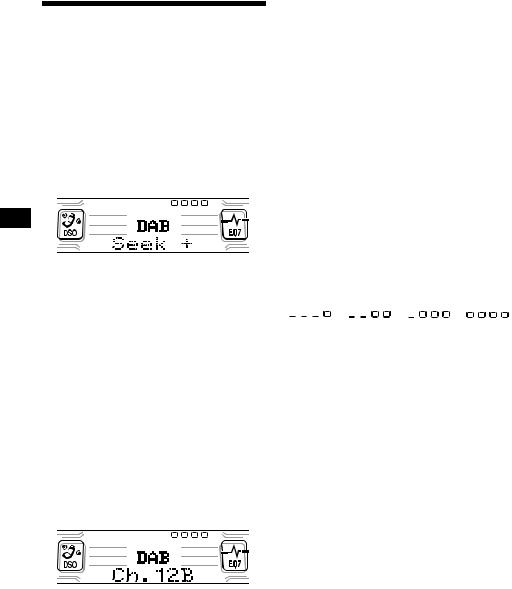
Basic operations of DAB
Searching for the ensemble and service
— Automatic Tuning
1 Press (SOURCE) repeatedly to select the radio.
2 Press (MODE) repeatedly to select
“DAB.”
3 Press and hold either side of (SEEK) until “Seek +” or “Seek –” appears.
The unit will stop seeking when an ensemble is located. The unit will then automatically select the first service and display its name, and the display indicator will change from “Seek +”/“Seek –” to the service name.
4 Press either side of (SEEK) to select the desired service.
Selecting the ensemble
— Manual Tuning
If you know the channel number of ensemble, follow the procedure below to tune in.
1 Press (SOURCE) repeatedly to select the radio.
2 Press (MODE) repeatedly to select
“DAB.”
3 Press either side of (DISC) until “Ch.
XXX” appears.
4 Press either side of (DISC) repeatedly until the desired channel number appears.
Receiving the preset services
Following procedure is available after presetting the service. For details on presetting the services, refer to “Presetting DAB services automatically,” (page 21) and “Presetting DAB services manually” (page 21).
1 Press (SOURCE) repeatedly to select the radio.
2 Press (MODE) repeatedly to select
“DAB.”
3 Press either side of (DISC) repeatedly to select the preset service.
Tip
There is another way to receive the preset service (preset on numbers 1 to 6).
Press the number button ((1) to (6)) on which the desired service is stored.
Refer to the level indication to check the receiving condition of the DAB programme. The level indication increases as the strength of the receiving signal increases.
level 1 level 2 level 3 level 4
If no service of the selected programme type is available, “----” will be displayed.
“----” will flash in the display if the reception is poor.
Note
To display the level indication, turn off the Motion Display (page 26).
20

Presetting DAB services automatically
— BTM
The BTM (Best Tuning Memory) function picks out DAB ensembles and automatically assigns the services within the ensembles to preset service numbers. The unit can preset up to 40 services.
If services have been previously set, the BTM function operates under the following conditions:
•If you activate the BTM function while listening to a preset service, the unit will store detected services (by overwriting) only to preset numbers higher than that of the current present service.
•If you activate the function while listening to a service that is not preset, the unit will replace the contents of all preset numbers.
•In both cases above, if the unit detects a service that is identical to one already preset, the previously stored service remains unchanged and the newly detected service is not preset.
1 While listening to a DAB programme, press (MENU).
2 Press either side of (DISC) repeatedly until “BTM” appears.
3 Press (ENTER).
A beep sounds when the service is stored. After activating the BTM function, the unit tunes the service assigned in the preset memory 1 automatically.
Note
If the unit can only tune in a few services, the BTM function may not assign services to all the preset service numbers.
Presetting DAB services manually
— Preset Edit
You can also preset DAB services manually or delete a service which is already preset. Note that up to 40 services (preset either by the BTM function or manually) can be preset to the unit’s memory.
1 While listening to a DAB programme, press (MENU).
2 Press either side of (DISC) repeatedly until “PRS Edit” appears, then press
(ENTER).
3 Select the service and the preset number you want to preset.
1Press either side of (SEEK) to select the service.
2Press either side of (DISC) to select the preset number.
3Press (ENTER).
The Preset Edit commands will appear in the display.
4 Press either side of (DISC) to select the desired command.
5 Press (ENTER).
To edit other services, repeat steps 3 and 4.
continue to next page t
21

Replacing the services in preset memories
Press either side of (DISC) to select “Over Wrt” in step 4, then press (ENTER).
Tip
There is another way to preset the service (on numbers 1 to 6).
After receiving the service, press the desired number button ((1) to (6)) until a beep sounds.
Adding the services in preset memories
Press either side of (DISC) to select “Insert” in step 4, then press (ENTER).
Note
“Insert” does not appear if the maximum number of services (40) is already preset in memory.
Erasing the services in preset memories
Press either side of (DISC) to select “Delete” in step 4, then press (ENTER).
Tuning in DAB programme through a list
Follow the procedure below to tune in a DAB programme manually.
1 While listening to a DAB programme, press (LIST) repeatedly until “E”
(ensemble list) appears.
E: ensemble list
S: service list
C: component list
P: preset list
All available ensembles will be listed.
2 Press either side of (DISC) until the desired ensemble appears, then press
(ENTER).
The first service for the ensemble is selected automatically.
3 Press (LIST) repeatedly until “S”
(service list) appears.
All services available for the ensemble will be listed.
4 Press either side of (DISC) repeatedly until the desired service appears, then press (ENTER).
The first component for the service is selected automatically.
5 Press (LIST) repeatedly until “C”
(component list) appears.
All components available for the service will be listed.
6 Press either side of (DISC) until the desired component appears, then press (ENTER).
22

Automatic updating of the ensemble list
When you perform the BTM function for the first time, all the ensembles available in your area are automatically stored. When you perform the BTM function again, the contents of these lists are updated in accordance with the conditions described on page 21.
An ensemble is added to the respective list when it is received during Automatic Tuning or Manual Tuning but is unlisted.
An ensemble is also deleted from the respective list when:
•you select an ensemble from the list, but it cannot be received.
•you perform Automatic Tuning or Manual Tuning to receive a listed ensemble, service, or the component, but it cannot be received.
Switching multi-channel audio and DRC
DAB can contain multi-channel audio. You can select main or sub-channel for reception. Also, if you turn on the DRC (Dynamic Range Control) function, the dynamic range on the service which supports DRC can automatically be extended. The following items can be set:
•BLGL — to select the channel from either “Main” (main-channel) or “Sub” (subchannel).
•DRC — to turn on or off the function.
1 While listening to a DAB programme, press (MENU).
2 Press either side of (DISC) repeatedly until “DRC” or “BLGL” appears.
3 Press either side of (SEEK) to select the desired setting (Example: “on” or “off”).
4 Press (ENTER).
Note
“BLGL” appears in the menu only when the unit is receiving a multi-channel programme.
Locating a DAB service by programme type (PTY)
You can use the PTY (Programme type selection) function to tune in the programme you want.
1 While listening to a DAB programme, press (DSPL/PTY).
2 Press either side of (DISC) repeatedly to select the programme type.
The programme types appear in the order shown on page 18.
3 Press (ENTER).
Searching for a service of the selected programme type begins automatically.
23
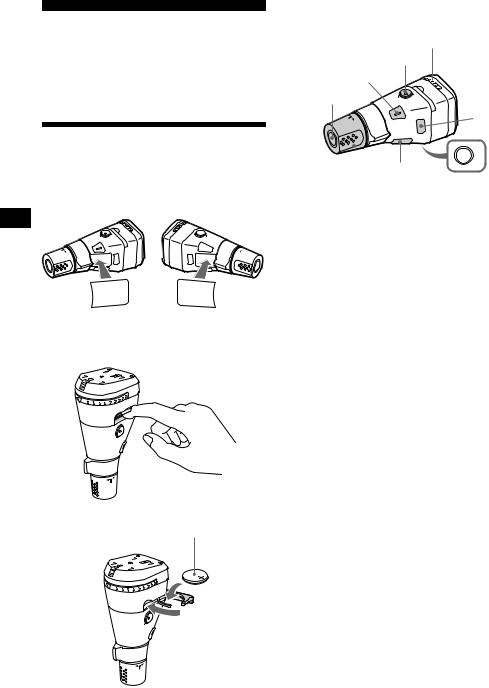
Other Functions
You can also control the unit (and optional CD/ MD units) with a rotary commander.
RM-X5S (supplied)
RM-X4S (optional)
Using the rotary commander
First, attach the appropriate label depending on how you want to mount the rotary commander. The rotary commander works by pressing buttons and/or rotating controls.
SOUND |
DSPL |
MODE |
MODE |
DSPL |
SOUND |
Inserting the supplied lithium battery (RM-X5S only)
x
+ side up
By pressing buttons
Turn the dial to change the direction of infrared rays. (RM-X5S only)
(ATT) (SOUND) 
(SOURCE)
(MODE)
|
OFF |
|
(DSPL) |
|
(OFF) |
|
|
Rotate the VOL control |
|
to adjust the volume. |
|
|
|
Press |
To |
|
|
(SOURCE) |
Change source |
|
(radio/CD/MD*1) |
(MODE) |
Change operation |
|
(radio band/DAB*1/CD unit/ |
|
MD*1 unit) |
(ATT) |
Attenuate sound |
|
|
(OFF)*2 |
Stop playback or radio |
|
reception |
|
|
(SOUND) |
Adjust the sound menu |
|
|
(DSPL) |
Change the display item |
|
|
*1 Only if the corresponding optional equipment is connected.
*2 If your car has no ACC (accessory) position on the ignition key switch, be sure to press (OFF) for
2 seconds to turn off the clock indication after turning off the ignition.
To turn the unit on, press the power on/off button on the unit.
Tip
For information on lithium battery, refer to “Notes on 24 lithium battery” (page 30).

By rotating the control
SEEK/AMS control
Rotate and release to:
–Skip tracks.
–Tune in stations automatically.
Rotate, hold, and release to:
–Fast-forward/reverse a track.
–Find a station manually.
By pushing in and rotating the control
PRESET/DISC control
Push in and rotate the control to:
–Receive preset stations.
–Change the disc*.
* When an optional CD/MD unit is connected.
Changing the operative direction
The operative direction of controls is factory-set as shown below.
To increase
To decrease
If you need to mount the rotary commander on the right hand side of the steering column, you can reverse the operative direction.
RM-X5S
Rev 
 Nor
Nor
Set the Rev/Nor-select switch to “Rev.”
RM-X4S
Press (SOUND) for 2 seconds while pushing the VOL control.
25

Adjusting the sound characteristics
You can adjust the bass, treble, balance, fader, and subwoofer volume.
The bass and treble levels and subwoofer volume can be stored independently for each source.
1 Select the item you want to adjust by pressing (SOUND) repeatedly.
Each time you press (SOUND), the item changes as follows:
BAS (bass) t TRE (treble) t
BAL (left-right) t FAD (front-rear) t
SUB (subwoofer volume)
2 Adjust the selected item by pressing either side of (SEEK).
When adjusting with the rotary commander, press (SOUND) and rotate the VOL control.
Note
Adjust within 3 seconds after selecting the item.
Quickly attenuating the sound
Press (ATT).
“ATT on” appears in the display momentarily.
To restore the previous volume level, press (ATT) again.
Tip
When the interface cable of a car telephone is connected to the ATT lead, the unit decreases the volume automatically when a telephone call comes in (Telephone ATT function).
Changing the sound and display settings
— Menu
The following items can be set:
Set Up
•Clock (page 9)
•CT (Clock Time) (page 19)
•Beep — to turn the beeps on or off.
•Multi language (language selection) — to change the display language to English, German, French, Italian, Dutch, Spanish, Portuguese, Swedish, Polish, Czech, or Turkish.
Display
•D.Info (Dual Information) — to display the clock and the play mode at the same time (on). Functions only when SA is not set to B-1 – B-5.
•SA (Spectrum Analyzer) (page 28) — to change the display pattern of the equalizer display.
•M.Dspl (Motion Display) — to select the Motion Display mode from “1,” “2,” and “off.”
–Select “1” to show decoration patterns in the display and activate Demo display.
–Select “2” to show decoration patterns in the display and deactivate Demo display.
–Select “off” to deactivate the Motion Display. The Demo display in the M.Dspl 1 mode will appear about 10 seconds after the unit is turned off.
•Dimmer — to change the brightness of the display.
–Select “Auto” to dim the display only when you turn the lights on.
–Select “on” to dim the display.
–Select “off” to deactivate the Dimmer.
•Contrast — to adjust the contrast if the indications on the display are not recognisable because of the unit’s installation position.
•A.Scrl (Auto Scroll)
–Select “on” to scroll all automatically displayed names exceeding 8 characters.
–When Auto scroll is set to off and the disc/ track name is changed, the disc/track name does not scroll.
26

Sound
•HPF (High pass filter) — to select the cut-off frequency to “off,” “78 Hz,” or “125 Hz.”
•LPF (Low pass filter) — to select the cut-off frequency to “78 Hz,” “125 Hz,” or “off.”
•Loud (Loudness) — to enjoy bass and treble even at low volumes. The bass and treble will be reinforced.
Play Mode
•Local on/off (Local seek mode) (page 14)
–Select “on” to only tune into stations with stronger signals.
•Mono on/off (Monaural mode) (page 14)
–Select “on” to hear FM stereo broadcast in monaural. Select “off” to return to normal mode.
•REG on/off (Regional) (page 16)
1 Press (MENU).
To set A.Scrl, press (MENU) during CD/MD playback.
2 Press either side of (DISC) repeatedly until the desired item appears.
3 Press the (+) side of (SEEK) to select the desired setting (Example: “on” or “off”).
4 Press (ENTER).
After the mode setting is completed, the display returns to normal play mode.
Note
The displayed item will differ depending on the source.
Tip
You can easily switch among categories by pressing either side of (DISC) for 2 seconds.
Setting the equalizer
You can select an equalizer curve for seven music types (Vocal, Club, Jazz, New Age, Rock, Custom, and Xplod).
You can store and adjust the equalizer settings for frequency and level.
Selecting the equalizer curve
1 Press (SOURCE) to select a source
(radio, CD, or MD).
2 Press (EQ7) repeatedly until the desired equalizer curve.
Each time you press (EQ7), the item changes.
To cancel the equalizing effect, select “off.” After 3 seconds, the display returns to the normal playback mode.
Adjusting the equalizer curve
1 Press (MENU).
2 Press either side of (DISC) repeatedly until “EQ7 Tune” appears, then press
(ENTER).
3 Press either side of (SEEK) to select the desired equalizer curve, then press (ENTER).
Each time you press (SEEK), the item changes.
4 Select the desired frequency and level.
1Press either side of (SEEK) to select the desired frequency.
Each time you press (SEEK), the frequency changes.
62 Hz y 157 Hz y 396 Hz y 1.0 kHz y 2.5 kHz y 6.3 kHz y 16 kHz
continue to next page t
27

2Press either side of (DISC) to adjust the desired volume level.
The volume level is adjustable by 1 dB steps from –10 dB to +10 dB.
To restore the factory-set equalizer curve, press (ENTER) for 2 seconds.
5 Press (MENU) twice.
When the effect setting is complete, the normal playback mode appears.
Selecting the spectrum analyzer
The sound signal level is displayed on a spectrum analyzer. You can select a display for ten patterns (A-1 to A-5 or B-1 to B-5), or the automatic display mode where all the patterns appear.
1 Press (SOURCE) to select a source
(radio, CD, or MD).
2 Press (MENU).
3 Press either side of (DISC) repeatedly until “SA” appears.
Setting the Dynamic
Soundstage Organizer (DSO)
If your speakers are installed into the lower part of the doors, the sound will come from below and may not be clear.
The DSO (Dynamic Soundstage Organizer) function creates a more ambient sound as if there were speakers in the dashboard (virtual speakers).
You can store the DSO setting for each source.
1 Press (SOURCE) to select a source
(radio, CD, or MD).
2 Press (DSO) repeatedly until “DSO on” appears.
To cancel the DSO function, select “DSO off” in step 2.
4 Press either side of (SEEK) repeatedly to select the desired setting.
5 Press (ENTER).
28

Labelling a Motion Display
You can label a Motion Display with up to 64 characters to appear when the unit is turned off. Labels will scroll in the display in the M.Dspl 1 mode (the display remains lit even when the power is off).
1 Press (OFF).
CD/MD playback or radio reception stops (the display remains on).
2 Press (MENU), then press either side of (DISC) repeatedly until “Name
Input” appears.
3 Press (ENTER).
4 Enter the characters.
1Press (DSPL/PTY) to select the character type.
A t a t 0 t A
2Press the (+)*1 side of
(DISC) repeatedly to select the desired character.
A t B t C t ... x t y t z t 0 t 1 t 2 ... t ! t “ t # ... t 
 *2 t A
*2 t A
*1 For reverse order, press the (–) side of
(DISC).
*2 (blank space)
3Press the (+) side of (SEEK) after locating the desired character.
If you press the (–) side of (SEEK), you can move back to the left.
4Repeat steps 1 to 3 to enter the entire sentence.
5 Press (ENTER).
Tips
•Simply overwrite or enter “ 
 ” to correct or erase a sentence.
” to correct or erase a sentence.
•To erase all sentences, press (ENTER) for 2 seconds after step 3.
Additional Information
Maintenance
Fuse replacement
When replacing the fuse, be sure to use one matching the amperage rating stated on the original fuse. If the fuse blows, check the power connection and replace the fuse. If the fuse blows again after replacement, there may be an internal malfunction. In such a case, consult your nearest Sony dealer.
Fuse (10 A)
Warning
Never use a fuse with an amperage rating exceeding the one supplied with the unit as this could damage the unit.
Cleaning the connectors
The unit may not function properly if the connectors between the unit and the front panel are not clean. In order to prevent this, detach the front panel (page 8) and clean the connectors with a cotton swab dipped in alcohol. Do not apply too much force. Otherwise, the connectors may be damaged.
Main unit
Back of the front panel
continue to next page t
29

Notes
•For safety, turn off the ignition before cleaning the connectors, and remove the key from the ignition switch.
•Never touch the connectors directly with your fingers or with any metal device.
Replacing the lithium battery
Under normal conditions, batteries will last approximately 1 year. (The service life may be shorter, depending on the conditions of use.) When the battery becomes weak, the range of the card remote commander becomes shorter. Replace the battery with a new CR2025 lithium battery.
x
+ side up
Notes on lithium battery
•Keep the lithium battery out of the reach of children. Should the battery be swallowed, immediately consult a doctor.
•Wipe the battery with a dry cloth to assure a good contact.
•Be sure to observe the correct polarity when installing the battery.
•Do not hold the battery with metallic tweezers, otherwise a short-circuit may occur.
WARNING
Battery may explode if mistreated.
Do not recharge, disassemble, or dispose of in fire.
Removing the unit
1 Remove the front cover
1Detach the front panel (page 8).
2Press the clip inside the front cover with a thin screwdriver.
3Repeat step 2 for the other side.
2 Remove the unit
1Use a thin screwdriver to push in the clip on the left side of the unit, then pull out the left side of the unit until the catch clears the mounting.
4 mm
2Repeat step 1 for the right side.
3Slide the unit out of its mounting.
30
